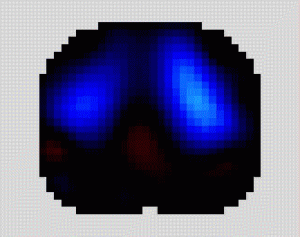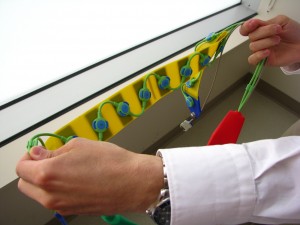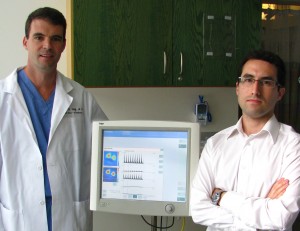
Can we monitor a child's lungs when they're on a ventilator without actually taking a picture? Yes, with a technology called EIT; click the image above to see for yourself. (Courtesy Camille Gómez-Laberge)
Every year, thousands of children in intensive care units across the United States are put on mechanical ventilation to help them breathe. But while this technology has saved countless lives, it can also cause or worsen lung injury.
“A child’s injured lungs don’t often inflate uniformly under ventilation,” says Gerhard Wolf, a critical care doctor in Children’s Hospital Boston’s Department of Anesthesia. “So one part of the lung may be nearly collapsed while another is overinflated. We need to be able to see that so we don’t cause further damage.”
The problem is that the lung is something of a black box. There is no good way of directly telling whether a ventilator is inflating a child’s lungs sufficiently. And while the use of continuous positive airway pressure systems during mechanical ventilation can in some cases help avoid damage, even there doctors would rather know exactly what is going on in the lung.
“We have learned very little about regional lung ventilation in the last 10 or 20 years,” Wolf explains, “largely because of limitations in the technologies available for looking at the lungs of a child on a ventilator.”
Blood gas measurements – the current standard of care – can show whether gases are getting into the bloodstream, but say nothing about regional lung inflation. Neither X-rays nor ultrasound show how air is distributed in the lung. CT scans give a better picture, but can only be used sparingly because of risks associated with radiation exposure. And while MRI or positron emission tomography (PET) can give valuable information, the scans can only be done in specialized suites; transporting such critically ill children to the equipment carries too much risk.
With a grant from Children’s Translational Research Program (TRP), Wolf and biomedical engineer Camille Gómez-Laberge, a postdoctoral fellow at Children’s, are leading a team that’s developing a solution for use at the patient’s bedside: electrical impedance tomography, or EIT.
It involves a portable device, connected to a belt of electrodes worn around the chest, that measures the passage of a weak, imperceptible electrical current through a child’s lungs. Since air does not conduct electricity, but the tissue of the lungs does, the paths taken by the currents as they pass through the lung tissue and around the air spaces can be translated into images that show the lungs’ shape and volume.
With a frame rate of 20 images per second, the technology can give Wolf and Gómez real-time information, viewable on a laptop, on how the volume of every part of the lung changes during each artificial breath. In essence, this approach brings the imaging suite to the bedside.
The multidisciplinary team, which includes respiratory therapists, critical care doctors (like Wolf) and engineers (like Gómez) has been collaborating with EIT experts worldwide in the laboratory for nine years to improve mechanical ventilation with lung imaging. Their research shows that adjusting the ventilator settings based on imaging data may optimize lung inflation. With the TRP grant, the team has begun a study using EIT to image ventilated patients in the Children’s Medical and Surgical ICU.

These electrodes could let respiratory therapists, nurses, and doctors "see" into the lungs of patients on ventilators.
Wolf thinks this technology could play a major role in avoiding ventilator-induced lung injury. “While we’re using EIT in conjunction with blood gas measurements for now,” he says, “we want to get to a point where EIT becomes a standard clinical tool that supplements blood gas as a way of assessing lung ventilation and making real-time ventilator adjustments.”
“We have a unique opportunity here at Children’s, because we regularly encounter very sick kids with lung injury,” Gómez adds. “Additionally, we have the right people for translating the technology into the ICU. This project is a great example of what engineering is all about − applying science for the benefit of people.”







